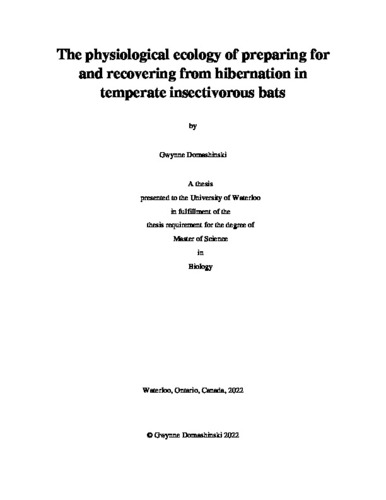| dc.description.abstract | Temperate insectivorous bats that hibernate must both prepare for and recover from hibernation during times of the year with low resource abundance and low ambient temperatures, resulting in energetic bottlenecks in both seasons. Assessing the energetic challenges of both seasons is important not only for an integrated comprehension of the scope of the annual cycle of hibernating bats, but also important for understanding the effects of white-nose syndrome (WNS) outside of hibernation. In this thesis, I focus on the seasons directly before and after hibernation to demonstrate the energetic demand of both seasons, and how WNS may exacerbate energetic challenges. In Chapter 2, I review literature concerning the post-emergence season, which presents a large knowledge gap in current understanding of the annual cycle of bats. I discuss the possible energetic challenges that bats may face during this season, and present possible challenges of WNS and climate change. In Chapter 3, I use morphometric and plasma metabolite data to analyze how hibernation preparation has changed in a region that has been affected by WNS for over a decade. Post-WNS, adult bats gained more mass before hibernation, and subadult bats, which previously lost mass, instead slightly increased body mass throughout the season. However, plasma triglyceride concentrations did not indicate any intense foraging throughout the season, despite documentation of elevated plasma triglycerides before the introduction of WNS. The results of this study were consistent with an adaptive response to WNS and may indicate changes in behavior and physiology that may result in reproductive trade-offs. Combined, my thesis emphasizes the significance of the pre- and post-hibernation seasons as energetic bottlenecks in the annual cycle, and the importance of considering the effects of WNS outside of the actual hibernation season, opening a variety of avenues for future research in the costs and challenges of hibernation. | en |

